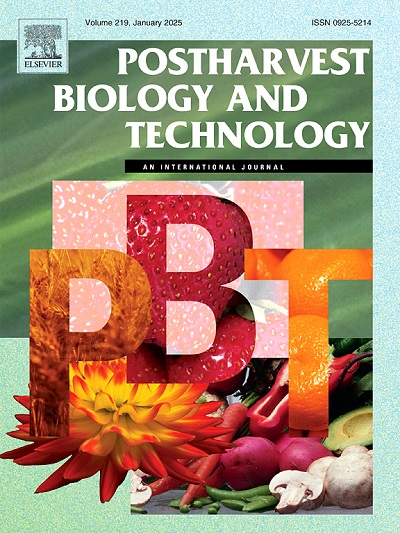Pathogens-induced disease development and ferroptosis of harvested blueberry fruit in association with membrane lipids metabolism
IF 6.8
1区 农林科学
Q1 AGRONOMY
引用次数: 0
Abstract
Lipidomics offers comprehensive insights into the cell mechanisms underlying the postharvest disease of fruits and vegetables. This study aimed to elucidate the regulatory mechanism of membrane lipids metabolism in diseased blueberry fruit, with a particular focus on iron-dependent cell death. Results showed that infections by A. alternata and F. fujikuroi elevated total iron and ferrous ion levels, decreased glutathione (GSH) and increased hydrogen peroxide (H2O2)/malondialdehyde (MDA) levels in lesion and adjacent areas. Iron ions and GSH correlated highly with lesion diameters, which was consistent with ferroptosis characteristics. Fatty acids analysis indicated that the destruction of unsaturated fatty acids in phospholipids of infected fruit was more obvious than that in total lipids, and methoxy fatty acids were notably increased in phospholipids but absent in total lipids. Lipidomic analysis revealed that phosphatidic acid (PA), phosphatidylcholine (PC), methylphosphatidylcholine (MePC) and monolysocardiolipin (MLCL) showed significant correlations with iron ions, GSH, MDA, and H2O2, respectively. The more stable PC and the less stable PA were both decreased, and cardiolipin (CL) was undetectable. MLCL was abundant initially but decreased during disease progression, possibly due to the membrane destabilization caused by peroxidation. Across phospholipids, 66.7 % of MLCL, 60.6 % of PC, 50 % of MePC, 42.9 % of PA, 16.7 % phosphatidylethanolamine (PE), 8.7 % phosphatidylglycerol (PG), 9.1 % phosphatidylserine (PS) exhibited significant correlations with 1–4 ferroptosis indicators (iron, MDA, H2O2 and GSH). These combined findings suggest that lipid peroxidation induced by A. alternata and F. fujikuroi may be linked to increased iron/H2O2 and decreased GSH level in blueberry cells.
病原体诱导的疾病发展和蓝莓果实铁下垂与膜脂代谢的关系
脂质组学为水果和蔬菜采后疾病的细胞机制提供了全面的见解。本研究旨在阐明患病蓝莓果实膜脂代谢的调控机制,特别关注铁依赖性细胞死亡。结果表明,交替孢霉和藤黑孢霉感染后,病变及邻近区域总铁和亚铁离子水平升高,谷胱甘肽(GSH)水平降低,过氧化氢(H2O2)/丙二醛(MDA)水平升高。铁离子和谷胱甘肽与病灶直径高度相关,与铁下垂特征一致。脂肪酸分析表明,侵染果实磷脂中不饱和脂肪酸的破坏比总脂中不饱和脂肪酸的破坏更为明显,且甲氧基脂肪酸在磷脂中显著增加,而在总脂中缺失。脂质组学分析表明,磷脂酸(PA)、磷脂酰胆碱(PC)、甲基磷脂酰胆碱(MePC)和单聚心磷脂(MLCL)分别与铁离子、GSH、MDA和H2O2呈显著相关。较稳定的PC和较不稳定的PA均下降,心磷脂(CL)未检出。MLCL最初是丰富的,但随着疾病的进展而减少,可能是由于过氧化引起的膜不稳定。在不同的磷脂中,66.7 %的MLCL、60.6 %的PC、50 %的MePC、42.9 %的PA、16.7 %的磷脂酰乙醇胺(PE)、8.7 %的磷脂酰甘油(PG)、9.1 %的磷脂酰丝氨酸(PS)与1-4个铁下垂指标(铁、MDA、H2O2和GSH)呈显著相关。这些综合研究结果表明,青霉和藤黑霉诱导的脂质过氧化可能与蓝莓细胞中铁/H2O2的增加和GSH水平的降低有关。
本文章由计算机程序翻译,如有差异,请以英文原文为准。
求助全文
约1分钟内获得全文
求助全文
来源期刊

Postharvest Biology and Technology
农林科学-农艺学
CiteScore
12.00
自引率
11.40%
发文量
309
审稿时长
38 days
期刊介绍:
The journal is devoted exclusively to the publication of original papers, review articles and frontiers articles on biological and technological postharvest research. This includes the areas of postharvest storage, treatments and underpinning mechanisms, quality evaluation, packaging, handling and distribution of fresh horticultural crops including fruit, vegetables, flowers and nuts, but excluding grains, seeds and forages.
Papers reporting novel insights from fundamental and interdisciplinary research will be particularly encouraged. These disciplines include systems biology, bioinformatics, entomology, plant physiology, plant pathology, (bio)chemistry, engineering, modelling, and technologies for nondestructive testing.
Manuscripts on fresh food crops that will be further processed after postharvest storage, or on food processes beyond refrigeration, packaging and minimal processing will not be considered.
 求助内容:
求助内容: 应助结果提醒方式:
应助结果提醒方式:


